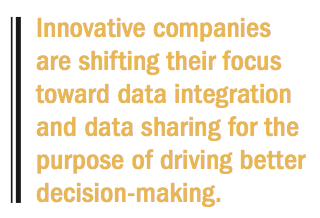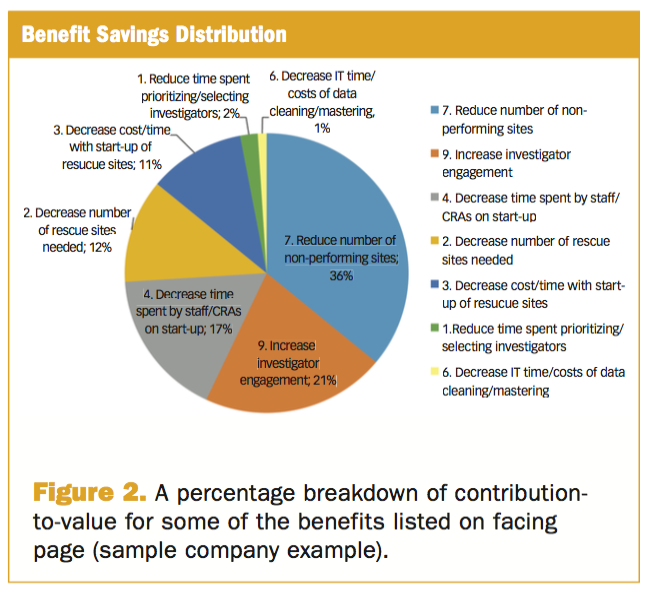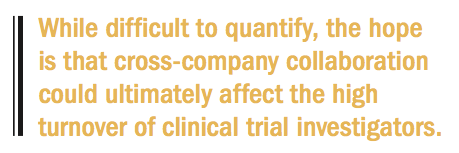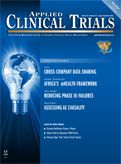The Data-Decision Debate: To Share or Not to Share?
Applied Clinical Trials
Exploring the benefits from cross-company data sharing for study planning and investigator selection.

We all know that finding the right investigative sites to conduct clinical trials is a critical step in ensuring the success of a study, and this task can be particularly complex in large global studies. When you consider that costs associated with initiating a site are estimated at $30,000, but 10% to 20% of investigative sites fail to enroll a single patient and an additional 37% of sites under enroll,1 it is no wonder that R&D costs are so high. The global R&D spend in 2015 was estimated at $141 billion,2 and analyses have estimated that just over 50% of R&D spend can be allocated to clinical research costs.3,4
Pharmaceutical companies and contract research organizations (CROs) have access to a variety of data sources to support finding and evaluating clinical trial sites, but these data are often spread across multiple internal and external systems. Because the cost to acquire data as well as the time and complexity required to integrate across these data sources is significant, companies often make suboptimal decisions related to study planning, feasibility and site selection.
Rather than continuing to individually amass disparate, costly data sources, innovative companies are shifting their focus toward data integration and data sharing for the purpose of driving better decision-making, which, in turn,

offers benefits to both researchers and investigators.
In a previous article,5 the authors established a hypothesis regarding the potential benefits likely to accrue to organizations that choose to collaborate on investigator information and leverage technology to view this integrated information:
- More informed protocol planning and country selection
- Increased access to investigators for feasibility and site identification
- Elimination of the need for staff to integrate information across data sources
- Faster and more predictable recruitment through better matching of investigators to protocols
- Cross-sponsor access to good clinical practice (GCP) training dates (and decreased time/costs for companies that waive training based on mutual recognition)
In this study, we begin the process of quantifying the potential value of cross-company collaboration, with a focus of looking at the impact of data integration and data sharing on study planning, site selection, site start-up and internal master data management.
Methods
To quantify the value of cross-company collaboration on study planning and investigator selection, a return on investment (ROI) model was developed based on the experience of pharmaceutical companies using the DrugDev SiteCloud platform to integrate disparate sources of clinical trial information and share data.
Data integration & data sharing service
An external consultancy, Hobson & Company, was engaged to facilitate the development of the ROI model using the following four step process:
1.Internal interviews: Five expert interviews were conducted with internal stakeholders representing multiple functional areas, including sales, marketing and subject matter experts. The objective of these interviews was to develop a hypothesized set of benefits that customers might expect to see from the data integration and data sharing solution described in Figure 1 below.

2. Customer feedback: In-depth interviews were conducted with 13 pharmaceutical company and CRO customers. The data provided by the customers was qualitative in nature and was collected during one-hour telephone interviews where customers were asked about the impact of data integration and data sharing on various areas of their business. The interviews sought to understand the key challenges experienced prior to data integration/sharing and the resulting sources of value and business improvement metrics post-implementation. The customers provided this information with the understanding that their responses would be shared but that their identity would remain confidential.
3. Model development: Based on the findings from the customer interviews, a final set of benefits was agreed, and a draft version of the ROI model was completed. Because the interviews revealed that the type and magnitude of benefits varied across customers, the model was constructed to capture a standard set of inputs and then allowed customers to tailor which benefits were included in the analysis and the magnitude of the value of each benefit. The draft ROI model was validated by one existing customer who provided perspective on the completeness, relevance and logic flow of the tool.
4. Model implementation and refinement: The ROI model has been implemented with several pharmaceutical company clients. During this implementation, the customer provided their actual information to input into the model including, but not limited to: number of studies per year, average duration of studies, average number of sites per study, time to do various activities, annual staff salary associated with activities, overhead rate and discount rate. A conference call was then scheduled to configure the benefits and outputs to reflect the value that each individual company could expect from data integration and sharing. Based on feedback received during actual implementation, small refinements have been made to the baseline value estimates included in the ROI model.
Results
Benefits
Results from customer interviews suggest that data integration and sharing has the potential to increase operational efficiencies, decrease budget expenditures and enhance investigator engagement. Table 1 below depicts the final list of benefits that emerged from the process (click to enlarge).

In the actual use of the ROI model to date, four benefits from the list in Table 1 have been included across all customer implementations:
- Decrease the number of rescue sites potentially needed
- Decrease time spent by staff and clinical research associates (CRAs) on site start-up
- Decrease IT time/costs of facility and investigator data mastering
- Increase investigator engagement
In contrast, two of the benefits in Table 1 were included by less than 30% of companies using the model:
- Reduce the number of protocol amendments
- Reduce over-recruitment of patients
Discussions with companies using the model suggest that these benefits were not included primarily because the company has already analyzed these processes and put in place process improvement measures to realize savings in these areas.
Value
For each benefit presented, Table 2 below summarizes the value driver, median and range of metrics provided by customers using the model.

Net present value of savings for a sample company
In this section, we estimate the net present value of the savings achievable over a five-year period by a sample organization that has an average of:
- 40 trials a year, 70 sites per trial, and 385 patients per trial
- 7.5 rescue sites per study with a start-up cost of $20,500 per site
- 18% of sites that don’t enroll
- 10% cost of capital
Based on the medians above, we would expect a net present value for the

sample company of $8.2 million over a five-year period.
Figure 2 at right (click to enlarge) presents a breakdown of this savings by benefit. As illustrated, for the sample organization, reducing the number of non-performing sites and increasing investigator engagement represent the majority of the value.
Limitations
The fact that the customer findings related to the benefits are anecdotal in nature, and are not necessarily based on actual documented savings is the greatest limitation of the model. That said, the sample organization inputs and outputs do reflect feedback from customers who are currently using and/or are very familiar with this system that provides data integration and cross-company data sharing. As such, we believe the results from the model do represent a good illustration of the actual savings companies would expect to see.
Generalizability is another limitation of this model. Every company that has used the model is different and this, along with a limited sample size of companies using the model, does mean it is difficult to generalize the findings. Customers have differing number of studies and designs (e.g., sites/patients) based on variation in therapy area. Differences in internal initiatives and SOPs also impact the benefits being selected or excluded as well as the value associated with each driver.
It is also important to note that while the model illustrates the total value created, some of the benefits documented may not translate into an actual reduction in annual expenditures (e.g., productivity gains do not always translate into cash savings). Nevertheless, the dollar value assigned by the model can be thought of as an “operational capacity gain,” where the time spent previously managing certain tasks can now be redeployed against other activities that may have otherwise required additional staffing.
Finally, we had great difficulty in quantifying one of the benefits: Decrease IT time/costs of facility and investigator data mastering. As discussed earlier, all customers using the ROI model found value associated with this benefit, but there was also agreement that the value resulting from the model is an under-estimate of what will likely be realized by most companies. This is primarily due to the fact that the value estimation is focused on a decrease in time spent on cleaning data, when the benefit to the organization extends well beyond study planning and site selection into other areas such as consolidated reporting for aggregate spend, master service agreement (MSA) negotiation, etc. (especially for companies who have grown through mergers and acquisitions and, as a result, have multiple clinical trial management systems).
Discussion
This paper describes an attempt to quantify the potential value of cross-company collaboration, with a focus of looking at the impact of data integration and data sharing on study planning, site selection, site start-up and internal master data management. While the value of data integration and sharing will vary depending on company characteristics, we estimate net present value over a five-year period to be approximately $8 million. Nearly 75% of this value to an average company is driven by three benefits: reducing the number of non-performing sites, increasing investigator engagement, and decreasing time spent by staff and CRAs on site start-up.
The concept of cross-company data sharing to support trial planning and site selection applies to many solutions across different areas of industry. Examples of such initiatives include networks of research sites (e.g., ACRES6 and the Global Health Network7), genomic data-sharing initiatives (e.g., NIH Genomic Data Sharing8 and the UK’s Genomics England9), and industry collaborative projects (e.g., Investigator Databank,10 TransCelerate’s Placebo and Standard of Care Data Sharing Initiative,11 Investigator Registry12 and Shared Investigator Platform13 and the European Innovative Medicines Initiative14).
The intent to look for efficiency gains from data integration and interoperability in various cross-company collaborations is also reflected at the company clinical trial management system (CTMS) level. Customers are demanding a greater degree of interoperability from their CTMS providers, and, thus, today’s CTMS solutions are increasingly offering integration with multiple clinical systems (e.g,. electronic data capture, randomization and trial supply management, interactive voice-response systems and financial information).15
Over and above the five-year savings documented in the model, all customers believe strongly that data integration and data sharing can have a very large impact on investigator satisfaction. While difficult to quantify, the hope is

that cross-company collaboration could ultimately affect the high turnover of clinical trial investigators. Working with unrealistic sponsor expectations can have a significant impact on investigator satisfaction, leading to turnover. Approaching investigators with studies that are better suited to their interest/experience, engaging investigators earlier in protocol development, and reducing the administrative burden of site start-up will contribute to better engagement not only in the start-up period documented in the model, but also throughout the entire study. Ultimately, having a positive study experience will hopefully result in more investigators choosing to continue to participate in clinical research.
Conclusion
This study has shown that companies looking for ways to reduce non-performing sites should consider investing in technology that enables integration of multiple sources of investigator, experience and trial recruitment data. Integrating a view across these sources is likely to result in more rapid recruitment as well as fewer zero-enrolling sites. For those organizations willing and able to share site study history and metrics, access to more robust site-level performance will generate even more efficiencies than data integration alone. And, the more organizations that agree to share data and collaborate on investigator-facing activities, the simpler clinical trial operations will be for investigators, which, in turn, has the potential to address another critical issue faced by the industry today: investigator turnover.
Claire Sears, PhD, is Director, DrugDev Data Solutions, email: claire.sears@drugdev.com; Elisa Cascade, MBA, is President, DrugDev Data Solutions, email: elisa.cascade@drugdev.com; Tammy Klein, MBA, is Partner, Hobson & Company, email: tammy@hobsonco.com
References
1. Tufts Center for the Study of Drug Development Impact Report, Volume 15, Number 1, January/February 2013
2. EvaluatePharma® World Preview 2015, Outlook to 2020. http://info.evaluategroup.com/rs/607-YGS-364/images/wp15.pdf
3. Allocation of research and development investments in pharmaceutical industry in 2013, by function. http://www.statista.com/statistics/315957/pharmaceutical-research-and-development-investment-allocation-by-function/
4. Getz, K. Sizing Up the Clinical Research Market. Applied Clinical Trials, March 1, 2010.
5. Sears and Cascade. Multiple Choice. International Clinical Trials, Winter 2015.
6. ACRES launches global clinical research network technology platform. Press Release August 2013. http://www.acresglobal.net/acres-launches-global-clinical-research-network-technology-platform/
7. Global Health Network Site Finder https://sitefinder.tghn.org/
8. NIH issues finalized policy on genomic data sharing. Press Release August 2014 http://www.nih.gov/news-events/news-releases/nih-issues-finalized-policy-genomic-data-sharing
9. Clinicians, Researchers and Industry collaborate with the 100,000 Genomes Project. Press Release March 2015. https://www.genomicsengland.co.uk/clinicians-researchers-and-industry-collaborate-with-the-100000-genomes-project/
10. Janssen Research & Development Announces Establishment
of Global Cross-Pharmaceutical Clinical Trial Investigator
Databank. Press Release November 2012. https://www.jnj.com/news/all/janssen-research-development-announces- establishment-of-global-cross-pharmaceutical-clinical-trial-investigator-databank
11. TransCelerate BioPharma Launches Two New Global Initiatives That Aim to Improve Clinical Research. Press Release April 2015. http://www.businesswire.com/news/home/20150408005116/en/TransCelerate-BioPharma-Launches-Global-Initiatives-Aim-Improve
12. TransCelerate BioPharma Inc. Launches Second-Year Initiatives, Expands Membership and Achieves Milestones for Original Projects. Press Release November 2013. http://www.prnewswire.com/news-releases/transcelerate-biopharma-inc-launches-second-year-initiatives-expands-membership-and-achieves-milestones-for-original-projects-230978611.html
13. TransCelerate BioPharma Launches the Shared Investigator Platform to Revolutionize Communications between Sites and Sponsors. Press Release January 2016. http://www.businesswire.com/news/home/20160120005463/en/TransCelerate-BioPharma-Launches-Shared-Investigator-Platform-Revolutionize
14. Innovative Medicines Initiative. http://www.imi.europa.eu/
15. Dagalur, S. CTMS: What You Should Know. Applied Clinical Trials, March 18, 2016
